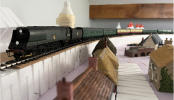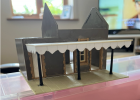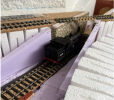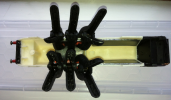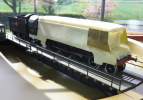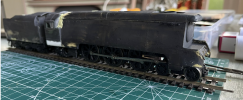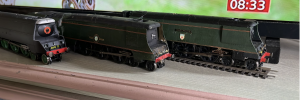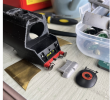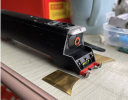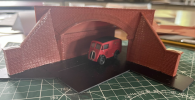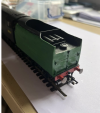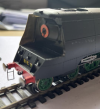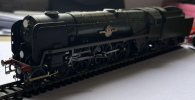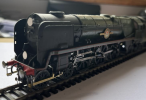Vardnoodleblast
Member
After many moons of thinking about it, collecting components, rolling stock, buildings, information and imagery, earlier this year I finally got underway on the 4mm model called Lyminster Junction, an imagineered alternative to Axminster. It is a junction on the Yeovil & Exeter section of the LSWR then Southern, then BR/SR. It is being constructed in a studio located over a double garage and utility room with eaves on each side of the floorspace which are to be used for 'off-stage' layout elements such as storage sidings.
The layout is planned to be operated in two periods. Firstly, pre-WWII circa 1935, with locos and rolling stock in the Maunsell olive green livery with rolling stock to suit, and secondly 1956, the year of my birth. Rule 1 applies, so to be seen in the future will be formations of more recent West of England trains hauled by Rebuilt Bulleid Pacifics, Warship diesels, Classes 33, 47 and 50.
In the grand scheme, LJ is the connection point of two branch lines which run to the coast. With a trailing connection to the junction one line leads to Lyminster, an equivalent of Lyme Regis in function. The other route also heads to the coast and terminates in what in reality is the Seaton area.
Construction so far has concentrated on one end of the layout where elevations of main line and branch plus the minimum 60" radius on the layout have to fit together with clearance of the timber roof supports. So far so good.
For the first time I have used Woodland Scenics dense styrofoam flexible track bed supports which has enabled me to trial the design using pins to hold the track bed support in place before applying adhesive and cork track bed. Similarly roads have been added and buildings placed to check for appearance. The constructed section presents a sweeping curve on an embankment that enters a rock cutting and short tunnel before entering the junction station area. This was a revised design where the mainline did not disappear under the eaves to re-emerge at the junction with sight of the train being lost for a lengthy section off-stage. The revision means it is possible to run a full 12 car train in full sight for 3 out of four sides of the room without seeing it negotiate tight radius curves.
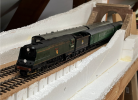
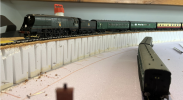
The first view is a mock-up of the scenic break to the junction station board. This is a very narrow section by necessity of providing access clearance for the stair well bannister. Originally the line was to go fully off stage under the eave but I decided on the narrow rock cutting approach to keep the train in continuous vision for longer, aiding the impression of distance on the approach to the junction. A road over-bridge could be an alternative to a short tunnel. A back scene board slots in behind the far styrofoam upright and I plan the intersection of foreground and background to be heavily foliaged. When all is complete I will add a fascia board of thin ply to neaten it all up. The tunnel mouth is made of chipboard sections with scribed DAS clay. The tunnel concept replicates Crewkerne Tunnel which was a mere 305 yards long. I presume this was a land owner requirement as otherwise opting up as a cutting would possibly make more sense.
The lower picture shows the embankment formed with dense styrofoam. It is seated on sheet styrofoam with a thin plywood under layer. Set 44 is shown in the original location for the branch. It will pass under the mainline. Its alignment has been changed since.
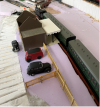
The branch runs in the foreground and after passing under the mainline enters a single platform halt. A leet passes under the branch just before a level crossing with the station road. Cutting down to the ply sheet provides the form for the water course. A siding is provided after the crossing which will add operational interest for trip working from the Junction.
The land forming in this area will be completed to give reason for the main line to swing left or 'south' and then go off-stage. Study of the Y&E routing shows that Joseph Locke made efficient use of the topography and in so doing incorporated numerous swinging curves avoiding the need to tunnel with a few exceptions, notably that of Honiton Tunnel and the steep approach gradient. The downhill rush from Honiton through Seaton Junction must have been spectacular in the day. I myself have witnessed a 47/7 in NSE days from the public footpath footbridge leaning into and out of the superelevation at full line speed. On my previous incarnation of Lyminster Junction it had a downgrade through the station (not really by design!) which also featured a sweeping 's' curve through the station with superelevation reversal. The effect was pleasing to the eye and the ear as a full 12 car rake clattered over the rail joints at speed. A touch of the Argo Transacord recordings there!
The Halt building is a much cut down Hornby 'Dunster' kit. A nice set of mouldings but it is over-scale necessitating using new doors with toplights as opposed to the mouldings provided. The canopy is formed using valence I had made by York Models for the Junction station which is modelled on Axminster itself. The cast columns are from cut down Hornby footbridge columns which are the correct profile for LSWR canopy supports. If in the final analysis if it looks too dominant in the foreground of this area, I would consider building a much smaller structure to replace it. Thought has been given to modelling it in 'closed' condition with boarded up windows and doors, overgrown platform and general dilapidation. I recall seeing a closed station modelled on a circular layout at Central Hall Westminster (Southend MRC) and that left an impression on me as it was quite 'atmospheric'. I also recall old OS maps from school geography lessons with white circles on single track railways instead of red, denoting closed stations on otherwise open lines.
The layout is planned to be operated in two periods. Firstly, pre-WWII circa 1935, with locos and rolling stock in the Maunsell olive green livery with rolling stock to suit, and secondly 1956, the year of my birth. Rule 1 applies, so to be seen in the future will be formations of more recent West of England trains hauled by Rebuilt Bulleid Pacifics, Warship diesels, Classes 33, 47 and 50.
In the grand scheme, LJ is the connection point of two branch lines which run to the coast. With a trailing connection to the junction one line leads to Lyminster, an equivalent of Lyme Regis in function. The other route also heads to the coast and terminates in what in reality is the Seaton area.
Construction so far has concentrated on one end of the layout where elevations of main line and branch plus the minimum 60" radius on the layout have to fit together with clearance of the timber roof supports. So far so good.
For the first time I have used Woodland Scenics dense styrofoam flexible track bed supports which has enabled me to trial the design using pins to hold the track bed support in place before applying adhesive and cork track bed. Similarly roads have been added and buildings placed to check for appearance. The constructed section presents a sweeping curve on an embankment that enters a rock cutting and short tunnel before entering the junction station area. This was a revised design where the mainline did not disappear under the eaves to re-emerge at the junction with sight of the train being lost for a lengthy section off-stage. The revision means it is possible to run a full 12 car train in full sight for 3 out of four sides of the room without seeing it negotiate tight radius curves.


The first view is a mock-up of the scenic break to the junction station board. This is a very narrow section by necessity of providing access clearance for the stair well bannister. Originally the line was to go fully off stage under the eave but I decided on the narrow rock cutting approach to keep the train in continuous vision for longer, aiding the impression of distance on the approach to the junction. A road over-bridge could be an alternative to a short tunnel. A back scene board slots in behind the far styrofoam upright and I plan the intersection of foreground and background to be heavily foliaged. When all is complete I will add a fascia board of thin ply to neaten it all up. The tunnel mouth is made of chipboard sections with scribed DAS clay. The tunnel concept replicates Crewkerne Tunnel which was a mere 305 yards long. I presume this was a land owner requirement as otherwise opting up as a cutting would possibly make more sense.
The lower picture shows the embankment formed with dense styrofoam. It is seated on sheet styrofoam with a thin plywood under layer. Set 44 is shown in the original location for the branch. It will pass under the mainline. Its alignment has been changed since.

The branch runs in the foreground and after passing under the mainline enters a single platform halt. A leet passes under the branch just before a level crossing with the station road. Cutting down to the ply sheet provides the form for the water course. A siding is provided after the crossing which will add operational interest for trip working from the Junction.
The land forming in this area will be completed to give reason for the main line to swing left or 'south' and then go off-stage. Study of the Y&E routing shows that Joseph Locke made efficient use of the topography and in so doing incorporated numerous swinging curves avoiding the need to tunnel with a few exceptions, notably that of Honiton Tunnel and the steep approach gradient. The downhill rush from Honiton through Seaton Junction must have been spectacular in the day. I myself have witnessed a 47/7 in NSE days from the public footpath footbridge leaning into and out of the superelevation at full line speed. On my previous incarnation of Lyminster Junction it had a downgrade through the station (not really by design!) which also featured a sweeping 's' curve through the station with superelevation reversal. The effect was pleasing to the eye and the ear as a full 12 car rake clattered over the rail joints at speed. A touch of the Argo Transacord recordings there!
The Halt building is a much cut down Hornby 'Dunster' kit. A nice set of mouldings but it is over-scale necessitating using new doors with toplights as opposed to the mouldings provided. The canopy is formed using valence I had made by York Models for the Junction station which is modelled on Axminster itself. The cast columns are from cut down Hornby footbridge columns which are the correct profile for LSWR canopy supports. If in the final analysis if it looks too dominant in the foreground of this area, I would consider building a much smaller structure to replace it. Thought has been given to modelling it in 'closed' condition with boarded up windows and doors, overgrown platform and general dilapidation. I recall seeing a closed station modelled on a circular layout at Central Hall Westminster (Southend MRC) and that left an impression on me as it was quite 'atmospheric'. I also recall old OS maps from school geography lessons with white circles on single track railways instead of red, denoting closed stations on otherwise open lines.


